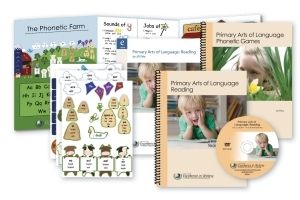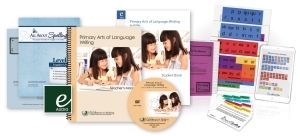Institute for Excellence in Writing (IEW) creates the best literacy curriculum sets available, at least in my opinion. Now we have the wonderful opportunity to review IEW's Primary Arts of Language: Reading Complete Package and Primary Arts of Language: Writing Complete Package. These curriculums are huge and packed with amazing activities, games and lessons! The Primary Arts of Language sets are ideal for children in grades K-2 and are specifically designed with special needs children in mind, but are still perfectly suitable for regular learners. Young children who struggle with reading or spelling will benefit from both of these curriculum sets.
We were thrilled with our IEW curriculum last year (Fix It! Grammar: The Nose Tree) and we were even more impressed with the complete reading and spelling packages. These are seriously in-depth curriculums that cover basically everything you can think of, as far as literacy lessons go.
One of the biggest bonuses to these curriculums is that they are fun. The games are fun to play and make it easier to work with children of different ages.

The Phonetic Games book has a checklist to help you keep track of your student's progress. There are 35 games that are consumable, so only one student can use them. You'll also find the story and game pieces at the back of the book, which are printed on thick cardstock paper. We organized them in two craft storage containers.

The helpful guide shows you how you're supposed to set up your magnet board. Ours is too small to fit all the tiles and still have room to practice using them, so we usually set them up around the outside of the board.
Bean likes to practice making words while I set up the lesson for the day. I'll help her sound out words and she'll find the appropriate letter tiles.
Munchkin doesn't always sit for the full length of our lessons (usually 20-40 minutes per day), but when he joins in, he plays with the letter tiles. I will find select tiles that make a word he is familiar with and scatter them. Then he puts them in what he thinks is the correct order.
There are dividers that come with the basic interactive kit, so you can easily organize your cards. The three dividers are for review, future lessons, and mastered cards.
The phonogram cards have a letter or two on the front (student side) and the sounds and key words on the back (teacher side).
The key cards are used to learn spelling rules, like what a consonant is and how to count syllables.
There are 170 word cards. We use them at the pace directed in the book, and we review them often.
As you work through the cards, they will move around a lot inside the box. I only use them with Bean, so it's easy to keep track of her progress. But it would be much harder with multiple children. So if you plan on using this curriculum with two or more children, then I suggest purchasing additional student packets and basic interactive kits.
The progress charts and certificates also come in the student packet. We keep them in plastic sleeves in our literacy binder and mark off our progress with a dry erase marker.
Not pictured is the student writing book. We print off the pages that we need at the beginning of the week and set them up in our daily work folders. I am considering purchasing the physical book, because I feel like it will make it a million times easier for Bean to keep all her materials in one place (not to mention save on ink costs). I personally would have preferred the student book to come with this set, but I understand why they made it available as a printable download.
Many of the lessons use multi-sensory teaching methods, which makes it easier to teach a group of children with different learning styles. We already use blended styles, focusing on visual and kinesthetic methods, and supplementing with auditory methods. Hands-on lessons seem to work for both of them, and I usually read about the subject while they play or work on the activity. Or as Bean is writing a letter or word, she will either sound it out or read it out loud. Using all three learning styles will mean that they learn more than if they were just focusing on one style.
The Writing lessons are divided into three parts. The first part is an introductory course and consists of 31 lessons. The second part has 40 lessons and the third part has 16 lessons. The lessons are completely customizable and can easily be modified to fit your child's needs. Children who excel at literacy studies may pace themselves at one lesson per day, while beginner or struggling students may complete one lesson per week. We always make sure to fully complete and understand a lesson before moving on to the next. Working at a student's pace makes it easier for them and they won't fall behind or feel overwhelmed.
Each student will have their own daily journal. They will learn to write the date and add a couple sentences about their day. We use a primary journal, so Bean also draws a picture about what she wrote about. Since she's still new to spelling, I sit beside her and help her sound out and spell words. If she doesn't feel like writing, but still wants to tell a story, I'll do the writing for her. When we first started with writing journals, I did all the writing, but now she is more comfortable and wants to do it for herself. Sometimes she'll tell me the story first and I'll write it down on a piece of paper and then she will copy it into her journal.
Teacher's can learn to teach confidently with the manuals as their guide. I read through all of the materials before even beginning the lessons. I wanted to understand how the lessons would be taught and took notes about things I might do differently. I always try the books methods first and if they don't work, I modify them to what words better for my kids. It's usually minor things, and it never effects the overall lesson.
Both of my children have small writing desks that are separate from our lessons, but usually come in handy. It has a draw and two containers that store colored pencils, pencils, erasers, pencil grips (which come in handy, since Bean has really dainty hands), letter stamps and ink pad, paper and a ruler. She does most of her solo writing at her desk and I believe the independent time is wonderful for her experience.
If you use technology in your homeschool, there are two free apps you can download that are phenomenal. They are designed by All About Learning Press and are called Letter Sounds A to Z and Phonogram Sounds (available on Android and Apple devices). You can use them with this curriculum and they are even great to use with toddlers and preschoolers to introduce letters and letter sounds. We have the apps on my Android phone and on both of the children's iPad's. We use the tablets during lessons and we use the phone app while we are in the car. We have created a few on-the-go games, like "can you spot something with the "ee" sound?" or "can you find something with the "ar" sound?" They use the app to hear and repeat the sound and then they announce when they find something with that sound, like a tree or car.
The Primary Arts of Language: Reading Complete Package is available for $69.00 and the Primary Arts of Language: Writing Complete Package is available for $89.00. Both of these sets are packed with amazing materials that you can use for several years. You can use the teacher's manuals for more than one student, but you'll need separate student materials for each child.
Be Social!
Read more reviews on Institute for Excellence in Writing's wonderful curriculum packages by clicking the banner below!





















No comments:
Post a Comment